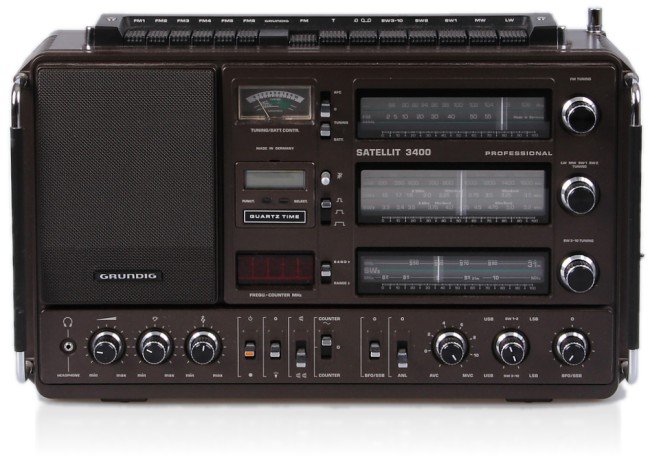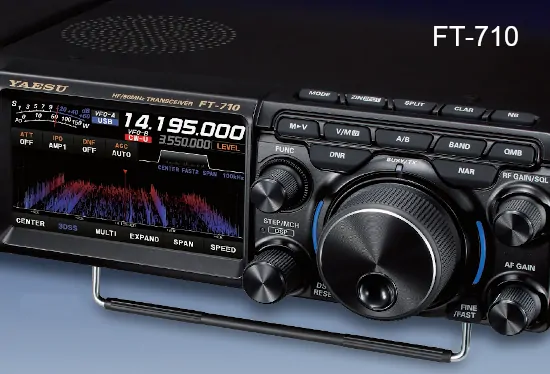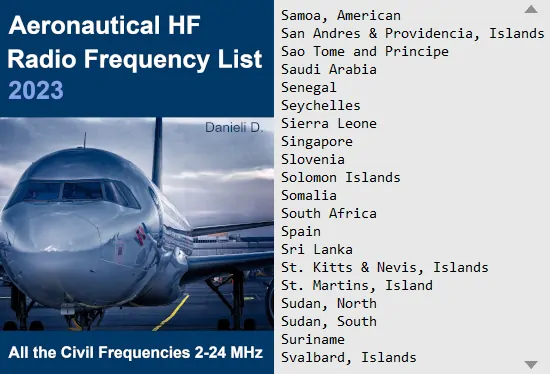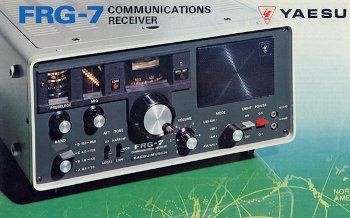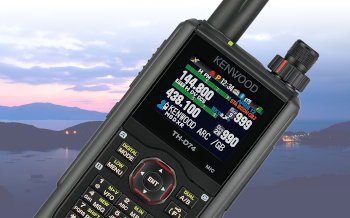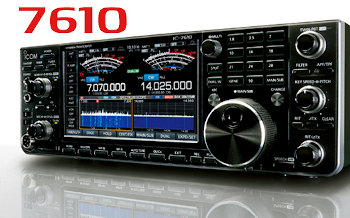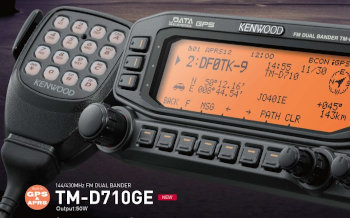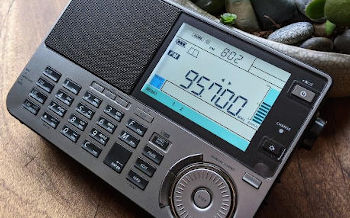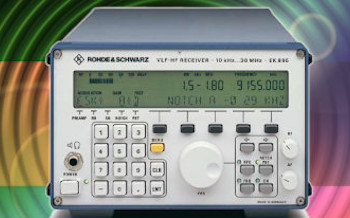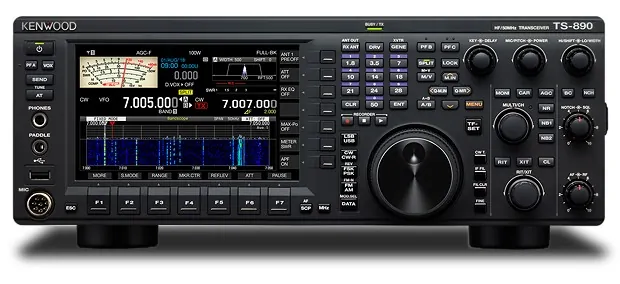
HF/50MHz/70MHz transceiver top in its class with very high dynamic range. 1st-IF frequency down conversion for its receive signal system, 500Hz roofing filter as standard, independent band scope, 7-inch TFT color display. 100W on HF/50 and 50W on 70 MHz, drive output supports 137kHz and 475kHz bands. Ideated in Japan, year of introduction 2018.
Reference market : amateur-radio
TS-890S specifications
| General |
| Frequency coverage | |
|---|---|
| Receive | 0.0300 ~ 74.8000 MHz [1] |
| Transmit | 0.1370 MHz band 0.4750 MHz band 1.8100 ~ 2.0000 MHz 3.5000 ~ 3.8000 MHz 5.2500 ~ 5.4500 MHz 7.0000 ~ 7.2000 MHz 10.1000 ~ 10.1500 MHz 14.0000 ~ 14.3500 MHz 18.0680 ~ 18.1680 MHz 21.0000 ~ 21.4500 MHz 24.8900 ~ 24.9900 MHz 28.0000 ~ 29.7000 MHz 50.0000 ~ 52.0000 MHz 70.0000 ~ 70.5000 MHz |
| Mode | |
| CW / PSK / FSK (RTTY) / LSB / USB / AM / FM | |
| Tuning step | |
| 1 Hz min | |
| Receiver |
| Sensitivity [2] | |
|---|---|
| CW / SSB | 0.5 uV (0.13~0.522 MHz, 10dB S/N) 4.0 uV (0.522~1.705 MHz, 10dB S/N) 0.2 uV (1.705~24.5 MHz, 10dB S/N) [3] 0.13 uV (24.5~30 MHz, 10dB S/N) 0.13 uV (50~54 MHz, 10dB S/N) 0.13 uV (70~70.5 MHz, 10dB S/N) |
| PSK / FSK | 0.5 uV (0.13~0.522 MHz, 10dB S/N) 4.0 uV (0.522~1.705 MHz, 10dB S/N) 0.2 uV (1.705~24.5 MHz, 10dB S/N) [3] 0.13 uV (24.5~30 MHz, 10dB S/N) 0.13 uV (50~54 MHz, 10dB S/N) 0.13 uV (70~70.5 MHz, 10dB S/N) |
| AM | 6.3 uV (0.13~0.522 MHz, 10dB S/N) 31.6 uV (0.522~1.705 MHz, 10dB S/N) 2.0 uV (1.705~24.5 MHz) [3] 1.3 uV (24.5~30 MHz, 10dB S/N) 1.3 uV (50~54 MHz, 10dB S/N) 1.3 uV (70~70.5 MHz, 10dB S/N) |
| FM | 0.22 uV (28~30 MHz, 12 dB SINAD) 0.22 uV (50~54 MHz, 12 dB SINAD) 0.22 uV (70~70.5 MHz, 12 dB SINAD) |
| Selectivity [4] | |
| CW | > 0.5 KHz (-6dB)
< 1.2 KHz (-60dB) |
| FSK | > 0.5 KHz (-6dB)
< 1.2 KHz (-60dB) |
| SSB | > 2.6 KHz (-6dB)
< 4.4 KHz (-60dB) |
| AM | > 6.0 KHz (-6dB)
< 12.0 KHz (-50dB) |
| FM | > 12.0 KHz (-6dB)
< 25.0 KHz (-50dB) |
| RF preamplifiers | |
| Preamp1 | Low-gain |
| Preamp2 | High-gain |
| RF attenuator | |
| 6 / 12 / 18dB | |
| DR (Dynamic Range) | |
| 110 dB (2 KHz spaced signals, 14.2 MHz, BW 500 Hz, Pre OFF) 110 dB (20 KHz spaced signals, 14.2 MHz, BW 500 Hz, Pre OFF) |
|
| RMDR (Reciprocal Mixing Dynamic Range) | |
| 122 dB (2 KHz spaced signals, 14.2 MHz, BW 500 Hz, Pre OFF) 124 dB (5 KHz spaced signals, 14.2 MHz, BW 500 Hz, Pre OFF) 125 dB (20 KHz spaced signals, 14.2 MHz, BW 500 Hz, Pre OFF) |
|
| Blocking | |
| 150 dB (2 KHz spaced signal, 14.2 MHz, BW 500 Hz, Pre OFF) 152 dB (100 KHz spaced signal, 14.2 MHz, BW 500 Hz, Pre OFF) |
|
| Synthesizer phase noise | |
| -148 dB typ (14.1 MHz, offset 1 KHz) -154 dB typ (14.1 MHz, offset 10 KHz) |
|
| Spurious and image rejection | |
| > 70 dB (HF bands) > 60 dB (50MHz band) > 60 dB (70MHz band) |
|
| IF rejection | |
| > 70 dB | |
| Notch filter | |
| Manual | > 70 dB Width selectable on Wide, Middle or Narrow |
| Automatic | > 60 dB > 40 dB (multi beat) |
| NB (Noise Blanker) | |
| Two type, can be used simultaneously | |
| DNR (Digital Noise Reduction) | |
| Two type | |
| RIT (Receiver Incremental Tuning) | |
| ± 9.999KHz | |
| AGC (Automatic Gain Control) | |
| Adjustable | |
| Frequency stability | |
| ± 0.1 ppm max with temperature from 0°C to +50°C | |
| IF (Intermediate Frequency) | |
| 1° | 8.248 MHz |
| 2° | 24 kHz 36 KHz (FM) |
| IF roofing filter [5] | |
| 0.5 / 2.7 / 6 / 15 KHz | |
| Squelch sensitivity | |
| SSB / CW / FSK / AM | < 5.6 uV (threshold, 0.13~0.522 MHz) < 18 uV (threshold, 0.522~1.705 MHz) < 1.8 uV (threshold, 1.705~30 MHz) < 1.1 uV (threshold, 50~54 MHz) < 1.1 uV (threshold, 70~70.5 MHz) |
| FM | < 0.2 uV (threshold, 28~30 MHz) < 0.2 uV (threshold, 50~54 MHz) < 0.2 uV (threshold, 70~70.5 MHz) |
| CW features | |
| Auto tuning Semi break-in (delay time 50-1000ms) / full break-in Pitch control in 5 Hz steps Audio peak filter Reverse mode LSB/USB |
|
| Transmitter |
| Output power | |
|---|---|
| CW / RTTY / SSB / FM | mW range (drive output for 137 and 475 kHz bands) 5 ~ 100 W (1.8~54 MHz bands) 5 ~ 50 W (70 MHz band) |
| AM | 5 ~ 25 W (1.8~54 MHz bands) 5 ~ 12.5 W (70 MHz band) |
| Spurious emission | |
| < -50 dB (1.8~29.7 MHz) < -63 dB (50 MHz) < -60 dB (70 MHz) |
|
| Carrier suppression (SSB) | |
| > 60 dB | |
| Unwanted sideband suppression (SSB) | |
| > 60 dB | |
| Maximum deviation (FM) | |
| ±5 kHz (wide) ±2.5 kHz (narrow) | |
| Audio response | |
| 100~2900 Hz (-6dB) | |
| Microphone | |
| 600Ω | |
| XIT (Transmitter Incremental Tuning) | |
| ± 9.999 KHz | |
| CW features | |
| Keyer 8 message memory |
|
| Antenna tuner | |
| Impedance range | 16.7 - 150Ω |
| Features |
| Memory | |
|---|---|
| 120 memories | |
| Display | |
| 7 inch TFT color display 1 Hz frequency resolution |
|
| Antenna | |
| 2 x SO239 50Ω RCA 50Ω (receiver only) |
|
| Power supply | |
| 13.8 Volt DC±15% external | |
| Power consumption | |
| 2.5A RX, no signal 22.5A TX, max power |
|
| Audio power | |
| 1.5W on 8Ω | |
| Audio output | |
| Jack 6.35 mm headphone Jack 3.5 mm external speaker |
|
| Connections | |
| Jack 8-pin (microphone) Jack 6.35 mm (CW paddle) Jack 6.35 mm (CW keyer) Jack 3.5 mm (keypad) Jack 3.5 mm (external analogue meter) RCA (antenna output) RCA (receiver antenna output) RCA (drive output) Socket 4-pin (antenna tuner) Socket 7-pin (linear amplifier) Socket 13-pin (accessories) BNC (10 MHz reference input) USB (PC, audio) USB (memory, keyboard) LAN RJ-45 (PC) DSUB 9-Pin (PC remote control) DVI-I (external display) |
| Mechanical and environmental data |
| Operating temperature | |
|---|---|
| from 0°C to +50°C | |
| Dimensions | |
| 396 (W) x 141 (H) x 340 (D) mm, projections not included 410 (W) x 158 (H) x 387 (D) mm, projections included |
|
| Weight | |
| 15.8kg |
- Guaranteed range 0.13-30 MHz, 50-54 and 70-70.5 MHz.
- Typical values.
- Receive sensitivity drops in the vicinity of the 1st IF frequency (8.248 MHz) due to IF trapping.
- Bandwidth example.
- 270Hz with YG-82CN-1 optional filter mounted.
The Kenwood TS-890S uses ~8 MHz 1st IF frequency down conversion for its receive signal system in order to use narrow bandwidth crystal filters with passband widths from 500Hz (or 270Hz with optional YG-82CN-1) as roofing filters to achieve strong exclusion of unnecessary adjacent signals mixer. The 1st converter is the H-mode mixer for top in its class dynamic range. 110dB 3rd-IMDR and 150dB blocking dynamic range measured under 2kHz spacing conditions. IF filter shape and AF (audio) filter selectable: switching is possible between 3 kinds of IF filter shapes (Medium / Soft / Sharp) as for post-demodulation voice audio passbands (Medium / Wide / Narrow). Combinations of these settings can adjust the sharpness of the demodulation signal. The radio carries a high definition 7-inch TFT color display. In addition to a diverse range of display content, the convenient "Auto Scroll Mode" provides strong support for competition or similar operation. Also up to 50 frequency marker function. Due to this independent receiver, the speed of the display of the waterfall is very high and also unaffected by the other settings.
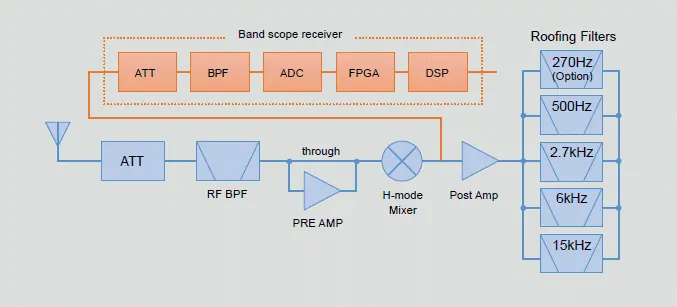
Kenwood TS890S receive signal system
Heavy-duty design delivers transmission performance able to withstand long hours of operation. The final stage amplifier device is a Mitsubishi-made MOSFET type RD100HHF1 (Pch = 176 Watt) operating in push-pull. A MOSFET type RD16HHF1 has been used for the drive amplifier, and a MOSFET type RD06HHF1 for the pre-drive stage. Inter-matching and fine tuning delivers superior transmit IMD even for a 13.8V final circuit, enabling operation with a clean and low-distortion signal.
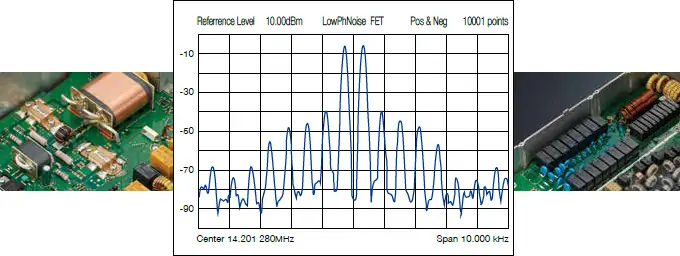
Kenwood TS-890S 100W final-stage amplifier circuit (left), transmit IMD, and automatic antenna tuner circuit (right)
Built-in high speed automatic antenna tuner enabling high-speed operation: the antenna tuner is a preset type also operable during receive and covering amateur bands from 1.8 to 70MHz. High-speed operation and the proven relay method enable rapid QSY through instantaneous band changing. The menu can be also used to set an ON/OFF memory for the antenna tuner for each band.
TS-890S features :
- All bands.
Including 60m, 6m, 4m bands and the 137 / 475 KHz new VLF bands. - Exceptional high dinamic range.
Strong large signal handling capabilities by H mode mixer and low phase noise local oscillator realised with superior C/N performance. - 7 inch (17.8cm) color display.
Partially with touch function, with the spectrum scope and waterfall screen the analogue meter is simultaneously displayed. The popular sub-scope display (from the TS-990S) has been incorporated as a filter-scope display. - Independant digital receiver for fast and wide waterfall display.
- Super fast IF DSP for accurate control of the AGC loop.
- Many filter and control options.
Notch, peak filter, noise reduction, noise blanker, beat cancel function, AGC quick recovery. - Receive only input and output antenna connector.
- Power Amp with 100W output for frequencies up to 54 MHz, 50W on 70 MHz.
- Built-in automatic tuner.
- Built-in TCXO.
- Built-in CW decoder.
Transmit with external USB keyboard or with built-in keyer for straight or paddle key. - Built-in RTTY and PSK-31/PSK-63 decoder/encoder.
Transmit with external USB keyboard. - Recording functions.
The radio comes equipped with a 1GB internal memory, and can record a maximum of roughly 9 hours of audio without using USB memory. When using USB memory there are no limits on the amount of audio recording. Recording options include normal, constant, timer. Recording can also be linked to the squelch. - DATA mode compatible.
- 3 programmable function keys.
- Remote operation achieved without host PC.
- DVI-I connector for external screen.
Narrow bandwidth roofing filters, performance that only full down conversion can provide. The transceiver uses 8.248 MHz 1st IF frequency down conversion for its receive signal system in order to continue the adjacent interference signal exclusion legacy refined in the TS-990S. Conversion characteristics have been improved with fine-tuning of input/output matching as well the device used. Dynamic range figures:
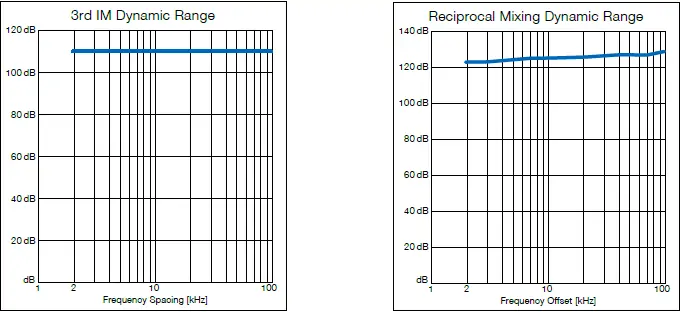
Kenwood TS-890 3rd IM Dynamic Range (left) and Reciprocal Mixing Dynamic Range (right)
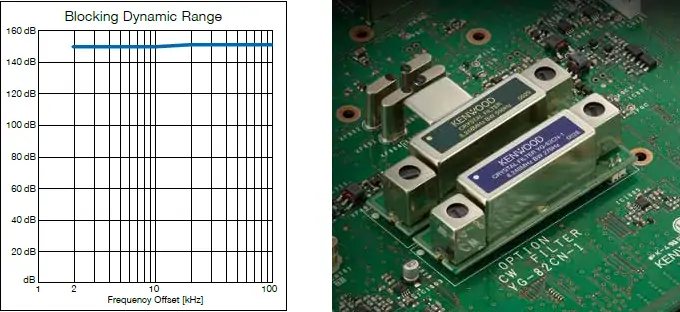
Kenwood TS-890 Blocking Dynamic Range (left) and the optional 270 Hz roofing filter installed (right)
Measurement conditions: Frequency 14.2 MHz, Preamplifier OFF, Bandwidth 500 Hz, mode CW. Horizontal axis: Interference signal interval (for 3rd IMDR - IM Dynamic Range) and interference signal isolation frequency (for RMDR - Reciprocal Mixing Dynamic Range, BDR - Blocking Dynamic Range).
TS-890S low noise local oscillator :
Interference signal exclusion is not determined by roofing filters and signal system devices alone. The transceiver has taken the VCO division of the TS-990S and developed it further, combining a VCO device with high Carrier-to-Noise in the GHz band and a reference oscillation circuit with superior adjacent C/N to deliver characteristics unattainable in conventional units.
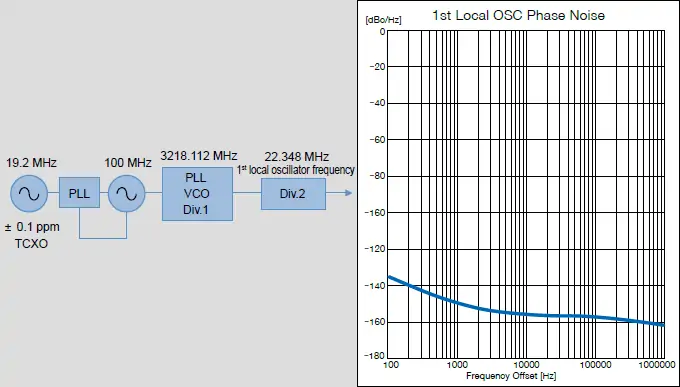
Kenwood TS-890S Local Oscillator system and Phase noise
Above, 1st local oscillator frequency generation when receiving at 14.1 MHz and Phase noise plot.
Just as in past transceivers, the TS-890S has attenuators of approximately 20dB for the medium wave band, 522 kHz to 1705 kHz. In the medium wave band, there are a number of strong radio waves and there may be medium wave band signal input that is excessive for low-band antennas. The inserted attenuators are intended for clear reception with no distortion even if such strong medium wave band signals are received. The signal can bypass the attenuator after switching the jumper pins on the board so as to allow the sensitivity to increase.
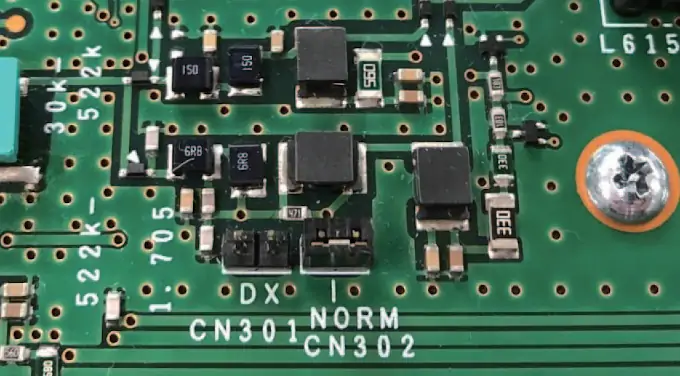
Kenwood TS-890S Medium Wave band Jumper pin locations
This is the image of the TX-RX unit board with the main band attenuator jumper pins placed. Detach the TS-890S lower case to access the TX-RX unit. Note, before detaching the lower case be sure to first detach the upper case - there is the danger of the cases being damaged. The jumper pins are placed in the "NORM" position at shipment. Switching the jumper pins to "DX" bypasses the attenuators and raises the medium wave band sensitivity by approximately 20 dB.
TS-890S IF Circuit :
The block diagram shown below shows the circuit configuration subsequent to the roofing filters. The first IF signal routes through the AGC amplifier and the first IF amplifier to the second mixer, which converts it to the second IF signal (24 kHz / 36 kHz). The second IF signal enters the DSP as the baseband signal through the second IF amplifier, and the AGC response, all-mode demodulation, and audio signal processing, etc., are done.

Kenwood TS-890, block diagram of the IF circuit for the Receiver
TS-890S notch filter :
A notch filter that operates in the IF stage. By eliminating strong interfering signals, it allows weak target signals to stand out. Damping range can be switched between three levels: Narrow, Middle or Wide. Enabling operation to match interference conditions.
TS-890S CW filter :
Audio peak filter, this is a narrow bandwidth filter operated during receive in CW mode. When intelligibility is low due to noise, it has the effect of floating the target signal and increasing intelligibility. The central frequency is linked to the pitch frequency, and can be given a maximum peak gain of +6dB.
TS-890S rear panel and connections :
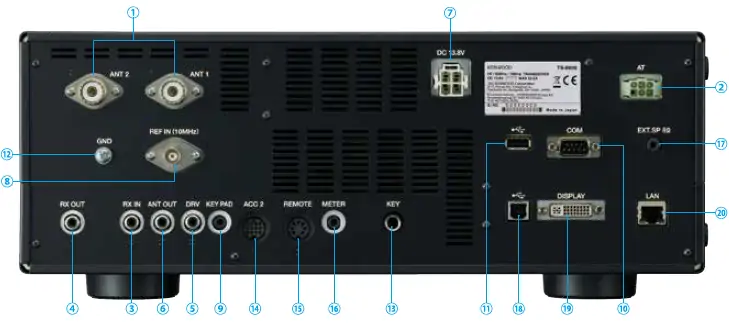
Kenwood TS-890S rear panel and connections
| Reference / Description | |
|---|---|
| 1 | [ANT 1, ANT 2] Antenna Connectors (SO239/M-type x 2). |
| 2 | [AT] For Connecting External Antenna Tuner (6 Pin). |
| 3 | [RX IN] For Connecting Receive Only Antenna (RCA). |
| 4 | [RX OUT] For Connecting External Receiver (RCA). |
| 5 | [DRV] Drive Output (RCA). |
| 6 | [ANT OUT] For Antenna Signal Distribution to External Receiver. |
| 7 | [DC 13.8V] For Connection of DC Power Source (4 Pin). |
| 8 | [REF-IN 10 MHz] For Standard External Signal Input (BNC). |
| 9 | [KEYPAD] For Connection of External PF Key (Jack 3.5). |
| 10 | [COM] For PC Control (D-SUB 9 Pin). |
| 11 | [USB-A] For USB Memory, Keyboard. |
| 12 | [GND] For Connection to Ground. |
| 13 | [KEY] For Paddle, Straight Key, and PC Keying (Jack 6.3). |
| 14 | [ACC2] For Connection of Audio I/O and Other Accessories (DIN 13 Pin). |
| 15 | [REMOTE] For Connection of Linear Amplifier (DIN 7 Pin). |
| 16 | [METER] For Connection of Commercial Analogue Meters (Jack 3.5). |
| 17 | [EXT.SP] For Connection of External Speakers (Jack 3.5). |
| 18 | [USB-B] For PC Control, USB Audio. |
| 19 | [DISPLAY] For Connection of External Display (DVI-I). |
| 20 | [LAN] For PC Control (RJ-45). |
TS-890S photo gallery :
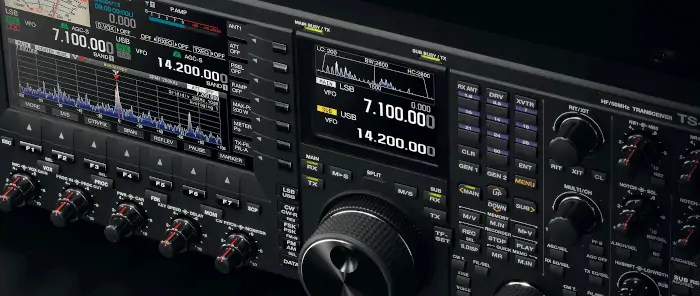
Kenwood TS-890 photo
TS-890S price
We have collected for your convenience the Kenwood TS-890 sale price (US Dollar) and its trend over time. Useful to guarantee a cheaper purchase of this radio and to put it for sale in the second-hand market. Of course offers, accessories, warranty terms and conditions can lead to different figures.
|
|
|
|
| USD 4599.95 | 2023-mar | Brand-new |
|
USD 4649.00 (3949EUR) |
2021-oct | Brand-new |
|
USD 5550.00 (4899EUR) |
2019-jan | Brand-new |
TS-890S review
| Martin Vee | December-15 2021 |
Fantastic radio in SSB and CW! Unfortunately AM transmit leaves something to be desired, specifically the AM transmit peak envelope power output, which is limited to 50W maximum. The specified carrier power is up to 25W maximum which is what I call "normal" for a 100W radio, but I fail to understand why Kenwood chose to squash the peak envelope power down to a unsymmetrical 50W PEP at 100% modulation? Every other 100W radio I've owned would do a 25W carrier and 100W PEP @ 100% modulation. Kenwood are you listening?
[End post]
Your opinion on merits, defects, experiences, with this radio set is welcome. Write your review, after a technical evaluation by our staff if found suitable will be published on this page. We thank you for your precious contribution.
